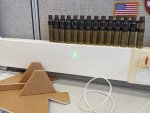Keiferson22
New member
- Joined
- Jun 13, 2020
- Messages
- 4
- Points
- 3
Hey all, I have a class 3R laser. I am using it to project the line of fire (barrel axis) of a weapon. In order to get rid of all of the messy diffused light associated with the laser spot I have chosen to pass the beam through two orthogonal polarized pieces of film. This has drastically reduced the intensity of the light but reduced the beam width by half which makes it more accurate for my application at very short distances.
Long story short, a safety review board was held to review my activity. A member of the board who is the "laser rep" started that I could not use a filter because I was focusing the beam. I think he misunderstood that the narrowing of the beam was a secondary effect of using the filter.
In my mind it's seems simple, if I can clearly see that the transmission level (intensity) is drastically reduced, then the laser output should be somewhat reduced as well.
Can someone back me up with an equation, law or principal? Or are I dead wrong? Shouldn't the output be reduced to a quarter of the original intensity?
Thanks in advance!
Long story short, a safety review board was held to review my activity. A member of the board who is the "laser rep" started that I could not use a filter because I was focusing the beam. I think he misunderstood that the narrowing of the beam was a secondary effect of using the filter.
In my mind it's seems simple, if I can clearly see that the transmission level (intensity) is drastically reduced, then the laser output should be somewhat reduced as well.
Can someone back me up with an equation, law or principal? Or are I dead wrong? Shouldn't the output be reduced to a quarter of the original intensity?
Thanks in advance!





